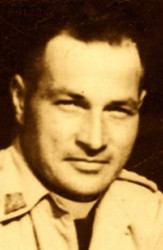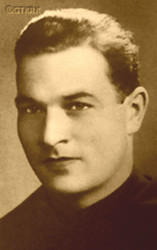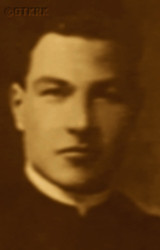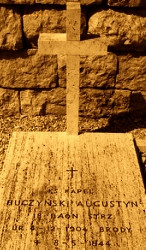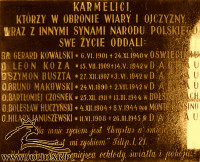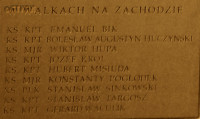Roman Catholic
St Sigismund parish
05-507 Słomczyn
85 Wiślana Str.
Konstancin deanery
Warsaw archdiocese, Poland
full list:
displayClick to display full list

searchClick to search full list by categories
wyświetlKliknij by wyświetlić pełną listę po polsku

szukajKliknij by przeszukać listę wg kategorii po polsku

Martyrology of the clergy — Poland
XX century (1914 – 1989)
personal data
surname
HUCZYŃSKI
forename(s)
Boleslav (pl. Bolesław)
religious forename(s)
Augustine (pl. Augustyn)
religious forename(s)
versions/aliases
Augustus (pl. August)
function
religious cleric
creed
Latin (Roman Catholic) Church RCmore on
en.wikipedia.org
[access: 2014.09.21]
congregation
Order of the Brothers of Our Lady of Mount Carmel OCarmmore on
en.wikipedia.org
[access: 2013.05.19]
(i.e. Carmelites)
diocese / province
Lviv archdiocesemore on
en.wikipedia.org
[access: 2013.05.19]
RC Military Ordinariate of Polandmore on
en.wikipedia.org
[access: 2014.12.20]
date and place
of death
08.05.1944

Monte Cassinon. Cassino
today: Frosinone prov., Lazio reg., Italy
more on
en.wikipedia.org
[access: 2023.03.16]
details of death
After the German and Russian invasion of Poland in 09.1939 and the start of World War II, resided in the Carmelite monastery in Lviv until 17.10.1939.
Arrested by the Russians on 17.11.1939 in Zaluchchya near Snyatyn, on the border Cheremosh River, where intended to cross over into Romania.
Jailed in a prison in Kiev (according to other sources in the KLW Kozelsk concentration camp in Kozelsk, and then in 06.1940 transported to the Gryazowiec concentration camp), and then to the Lubyanka and Butyrka prisons in Moscow.
There, on 21.09.1940, sentenced to 8 years of slave labor in the Russian Gulag concentration camps.
Sent to the ITL SevDvinLag concentration camp (part of the PPLp KotlasLag concentration camp complex), where slaved on the construction of a railway line.
After the German attack on 22.06.1941 of its erstwhile ally, the Russians, at the end of 1941 released by virtue of the Polish–Russian Sikorski–Mayski agreement.
Rreached the headquarters of the forming Polish Armed Forces in Russia, commonly called the Anders Army after the commander, General Vladislav Anders, in the hamlet of Kultubanka near Buzuluk on the Samara River, the left tributary of the Volga (today Orenburg district).
Became the chaplain of the 18th Infantry Regiment of the 6th Lviv Infantry Division, forming in the village of Totskoye on the Samara River.
At the turn of 01‐02.1942, due to the Russians hindering the formation of the army, the Regiment was moved to the village of Chirakchi (today Kashkadarya vilayet in Uzbekistan).
The Russians continued to hinder the formation of the army — the sanitary and food conditions were tragic — and on c. 20.08.1942 the Regiment was transported to Krasnovodsk (today Turkmenbashi), and then left the Russian „inhuman land” via the Caspian Sea and was transported to Pahlevi (today Bandar‐e Anzali) in Iran, and from there on 05.09.1942 first to the camp in Khanaqin in Iraq, and then on 19.10.1942 to the Qizil Ribat camp, c. 30 km away, on the road to Baghdad.
From 31.10.1942, in during the reorganization, became the chaplain of the 18th Lviv Rifle Battalion of the 6th Lviv Brigade within the 5th Borderlands Infantry Division of the Polish Army in the East.
In 04.1943 transported to a camp in the Kirkuk area, where his battalion protected oil fields and transmission pipelines.
From there, on 07‐20.08.1943, the Brigade — already part of the 2nd Polish Corps, under the command of Gen. Anders, established on 21.07.1943 — transported to a camp near Maghazi–Nuseirat (today in the Gaza Strip) in the British Mandate of Palestine.
At the end of 01.1944, moved to a military camp in Kassassin in Egypt, c. 35 km from Ismaili on the Suez Canal, where a period of intensive training, completing the full‐time units, weapons and equipment, which lasted about a year, ended.
In 02.1944 the Brigade was transported to Port Said on the Mediterranean Sea, from where it shipped by sea to Taranto in Apulia, a port in southern Italy.
From there, on 19‐24.03.1944, transported to the front zone on the Sangra River, along which the Germans had organized a heavily defended Gustav Line, intended to prevent the Allies from invading Rome and central Italy.
Perished during what was probably „the biggest land battle in Europe — the most intense and bloodiest of the battles between the Western Allies and the German Wehrmacht on all fronts of World War II”, and at the same time the greatest triumph of Polish arms during World War II, at Monte Cassino — suffered the death of a soldier, as a chaplain, while ministering to the soldiers, hit by a grenade shrapnel.
cause of death
explosion
perpetrators
Germans
sites and events
Gen. Anders army’s evacuation to IranClick to display the description, ITL SevDvinLagClick to display the description, PPLp KotlasLagClick to display the description, GulagClick to display the description, Moscow (Butyrki)Click to display the description, Moscow (Lubyanka)Click to display the description, KLW KozelskClick to display the description, Kiev (Lyukyanivska)Click to display the description, Ribbentrop‐MolotovClick to display the description, Pius XI's encyclicalsClick to display the description
date and place
of birth
04.12.1904

Brodytoday: Brody urban hrom., Zolochiv rai., Lviv obl., Ukraine
more on
en.wikipedia.org
[access: 2020.11.20]
parents
HUCZYŃSKI Joseph
🞲 ?, ? — 🕆 ?, ?

HEJNICKA Mary
🞲 ?, ? — 🕆 ?, ?
religious vows
04.09.1922 (last)
presbyter (holy orders)
ordination
17.12.1927

Rometoday: Rome prov., Lazio reg., Italy
more on
en.wikipedia.org
[access: 2021.12.18]
positions held
1941 – 1944
RC military chaplain — 18th Lviv Rifle Battalion of the 6th Lviv Brigade, in the 5th Borderlands Infantry Division, part of the 2nd Polish Corps, Polish Armed Forces (formed „in the West”), Polish Armed Forces — from 31.10.1942; earlier, from c. 12.1941, chaplain of the 18th Infantry Regiment of the 6th Lviv Infantry Division of the Polish Armed Forces in Russia
1939
prior — Rozdiltoday: Novyi Rozdil urban hrom., Stryi rai., Lviv obl., Ukraine
more on
en.wikipedia.org
[access: 2022.08.05] ⋄ monastery, Carmelites OCarm — also: catechist at local public schools
till 1939
monk — Krakówtoday: Kraków city pov., Lesser Poland voiv., Poland
more on
en.wikipedia.org
[access: 2021.06.07] ⋄ monastery („na Piasku” („on the Sand”)), Carmelites OCarm
from 1927
student — Krakówtoday: Kraków city pov., Lesser Poland voiv., Poland
more on
en.wikipedia.org
[access: 2021.06.07] ⋄ history of art, Jagiellonian University UJ — also: scientist
till 1927
student — Rometoday: Rome prov., Lazio reg., Italy
more on
en.wikipedia.org
[access: 2021.12.18] ⋄ theology
student — Krakówtoday: Kraków city pov., Lesser Poland voiv., Poland
more on
en.wikipedia.org
[access: 2021.06.07] ⋄ Philosophical and Theological Studies (Studium domesticum pro religiosis), monastery („na Piasku” („on the Sand”)), Carmelites OCarm
from 04.09.1921
monk — Krakówtoday: Kraków city pov., Lesser Poland voiv., Poland
more on
en.wikipedia.org
[access: 2021.06.07] ⋄ monastery („na Piasku” („on the Sand”)), Carmelites OCarm
sites and events
descriptions
Gen. Anders army’s evacuation to Iran: In 08‐09.1941 joint British and Russian invasion of Iran ( „Operation Y”) took place. On 17.09.1941 Teheran was jointly captured by British and Russian troops. When at the beginning of 1942 the Russians reduced the number of food rations for the Polish Army in Russia by two thirds, sufficient for c. 30,000 soldiers, while the Army's personnel numbered c. 70,000 former prisoners of Russian concentration camps, the Army commander, General Vladislav Anders, decided to withdraw Polish troops from Russia. Altogether 75,003 militaries and 41,128 civilians, including c. 20,000 children, Polish victims of Russian deportations, prisons and concentration camps reached Iran between 12.03.1942 and 09.1942. One of the transit camps was in Mashhad in northern Iran, in Russian occupation zone, which 2,694 people, mainly civilians including 1,704 children (Mary Anne Tyszkiewicz known under artistic name of Hanka Ordonówna, famous Polish singer) went through. There on a separate patch of Armenian cemetery 29 Polish refugees, including 16 soldiers were buried — victims of car accidents on treacherous road from Russia and devastation and exhaustion from past experiences in Russia. Altogether 600 Polish soldiers, „43 junior‐boys, 17 junior‐girls, 13 volunteers of Women’s Support Services and 2 sisters of Red Cross” perished in Iran… (more on: en.wikipedia.orgClick to attempt to display webpage
[access: 2019.05.30])
ITL SevDvinLag: Russian Rus. Исправи́тельно‐Трудово́й Ла́герь (Eng. Corrective Labor Camp) ITL Rus. Северо‐Двинский (Eng. North‐Dvinsk) — concentration and slave forced labor camp (within the Gulag complex) — based in Velsk, Arkhangelsk Oblast, where prisoners slaved on the construction of the Konosha‐Kotlas railway line, among others. Founded on 25.09.1940 and closed on 04.09.1946 (transferring prisoners to another camp). Among the prisoners were many Poles deported by the Russians after the Russian attack on Poland on 17.09.1939 and the start of World War II. At its peak — after the German attack on 22.06.1941 against its erstwhile ally, the Russians — over 40,000 prisoners were held there: e.g. 42,117 (01.07.1941); 34,425 (01.01.1942); 20,663 (01.01.1943).
PPLp KotlasLag: Russian Rus. Пересыльно‐Перевалочный Лагпункт (Eng. Transfer and Transshipment Camp) PPLp Rus. Котласский (Eng. Kotlaskiy) — transit camp (within the Gulag complex) — headquartered in Kotlas in Arkhangelsk Oblast. Established on 06.06.1931 as a subcamp of the ITL UstVymLag1 concentration camp, 05.03.1932‐31.07.1932 an independent subcamp of the Gulag, then until 14.05.1940 a subcamp of the ITL UkhtPechLag camp, again until 14.05.1940 an independent subcamp of the Gulag, until 27.10.1943 a subcamp managed by the Ministry of Railway Transport, until 29.07.1945 part of the PPLp KotlasLag agricultural concentration camp. From 29.06.1945 PPLp KotlasLag functioned as a subcamp of the ITL SevPechLag concentration camp, dealing exclusively with food production. Prisoners slaved at storage and transport of goods to and from concentration camps in the Komi Republic, construction materials for the North Pechora Railway Main Line, and after the camp on 27.10.1943 was transformed into an agricultural camp at food production, etc. At its peak — till the death on 05.03.1953 of Russian socialist leader, Joseph Stalin — c. 9,000 prisoners were held there: e.g. 8,073 (01.07.1940); 8,716 (01.01.1943); 8,629 (01.01.1944); 6,207 (01.01.1945), among whom were many Poles. As a transshipment sub‐camp it ceased to exist in 1945, but as an agricultural camp in 1956. (more on: old.memo.ruClick to attempt to display webpage
[access: 2024.04.08], www.gulagmuseum.orgClick to attempt to display webpage
[access: 2014.11.14])
Gulag: The acronym Gulag comes from the Rus. Главное управление исправительно‐трудовых лагерей и колоний (Eng. Main Board of Correctional Labor Camps). The network of Russian concentration camps for slave labor was formally established by the decision of the highest Russian authorities on 27.06.1929. Control was taken over by the OGPU, the predecessor of the genocidal NKVD (from 1934) and the MGB (from 1946). Individual gulags (camps) were often established in remote, sparsely populated areas, where industrial or transport facilities important for the Russian state were built. They were modeled on the first „great construction of communism”, the White Sea‐Baltic Canal (1931‐1932), and Naftali Frenkel, of Jewish origin, is considered the creator of the system of using forced slave labor within the Gulag. He went down in history as the author of the principle „We have to squeeze everything out of the prisoner in the first three months — then nothing is there for us”. He was to be the creator, according to Alexander Solzhenitsyn, of the so‐called „Boiler system”, i.e. the dependence of food rations on working out a certain percentage of the norm. The term ZEK — prisoner — i.e. Rus. заключенный‐каналоармец (Eng. canal soldier) — was coined in the ITL BelBaltLag managed by him, and was adopted to mean a prisoner in Russian slave labor camps. Up to 12 mln prisoners were held in Gulag camps at one time, i.e. c. 5% of Russia's population. In his book „The Gulag Archipelago”, Solzhenitsyn estimated that c. 60 mln people were killed in the Gulag until 1956. Formally dissolved on 20.01.1960. (more on: en.wikipedia.orgClick to attempt to display webpage
[access: 2024.04.08])
Moscow (Butyrki): Harsh transit and interrogation prison in Moscow — for political prisoners — where Russians held and murdered thousands of Poles. Founded prob. in XVII century. In XIX century many Polish insurgents (Polish uprisings of 1831 and 1863) were held there. During Communist regime a place of internment for political prisoners prior to a transfer to Russian slave labour complex Gulag. During the Great Purge c. 20,000 inmates were held there at any time (c. 170 in every cell). Thousands were murdered. (more on: en.wikipedia.orgClick to attempt to display webpage
[access: 2020.05.01])
Moscow (Lubyanka): Location of a murderous Russian Cheka and next GPU and NKVD (later MVD and KGB) organisations and a prison (in the basement, with 118 cells — in 1936 — of which 94 were solitary — altogether at any time up to 350 prisoners were held there and c. 2,857 in 1937) in Moscow at Lubyanka Square where Russians interrogated and murdered many political prisoners. Most of the prisoners after investigations were transferred to other Moscov prisons, e.g. Butyrki. (more on: en.wikipedia.orgClick to attempt to display webpage
[access: 2014.10.31])
KLW Kozelsk: Russian Rus. Концентрационный Лагерь для Военнопленных (Eng. POW Concentration Camp) KLW, run by genocidal Russian NKVD organization, for Poles arrested after the invasion in 1939, operating in 1939‐1940 in Kozelsk — on the premises of the 18th century Orthodox Stauropygial Introduction of the Mother of God into the Temple Optyn Monastery, shut down and robbed by the Russian Bolsheviks in 1923. In 04‐05.1940, c. 4,594 people were detained there, who were then — as part of the implementation of the decision of the Russian authorities to exterminate dozens thousands of Polish intelligentsia and military personnel — murdered in Katyn. The prisoners included one rear admiral of the Polish Navy, four generals, c. 100 colonels and lieutenant colonels, c. 300 majors and c. 1,000 captains and captains of the Polish Army. Around half of them were reserve officers, including: 21 professors, associate professors and lecturers at universities, over 300 doctors, several hundred lawyers, several hundred engineers, several hundred teachers and many writers, journalists and publicists. There was also one woman, 2nd Leutenant pilot Janine Lewandowska. (more on: pl.wikipedia.orgClick to attempt to display webpage
[access: 2012.11.23])
Kiev (Lyukyanivska): Russian political prison in Kiev, in the first half of 20th century run by the genocidal NKVD, informally referred to as prison No 1, formally as Investigative Prison No 13 (SIZO#13). It was founded in the early 19th century. In the 20th century, during the Soviet times, the prison church was transformed into another block of cells. During the reign of J. Stalin in Russia, more than 25,000 prisoners passed through it. (more on: en.wikipedia.orgClick to attempt to display webpage
[access: 2014.09.21])
Ribbentrop‐Molotov: Genocidal Russian‐German alliance pact between Russian leader Joseph Stalin and German leader Adolf Hitler signed on 23.08.1939 in Moscow by respective foreign ministers, Mr. Vyacheslav Molotov for Russia and Joachim von Ribbentrop for Germany. The pact sanctioned and was the direct cause of joint Russian and German invasion of Poland and the outbreak of the World War II in 09.1939. In a political sense, the pact was an attempt to restore the status quo ante before 1914, with one exception, namely the „commercial” exchange of the so‐called „Kingdom of Poland”, which in 1914 was part of the Russian Empire, fore Eastern Galicia (today's western Ukraine), in 1914 belonging to the Austro‐Hungarian Empire. Galicia, including Lviv, was to be taken over by the Russians, the „Kingdom of Poland” — under the name of the General Governorate — Germany. The resultant „war was one of the greatest calamities and dramas of humanity in history, for two atheistic and anti‐Christian ideologies — national and international socialism — rejected God and His fifth Decalogue commandment: Thou shall not kill!” (Abp Stanislav Gądecki, 01.09.2019). The decisions taken — backed up by the betrayal of the formal allies of Poland, France and Germany, which on 12.09.1939, at a joint conference in Abbeville, decided not to provide aid to attacked Poland and not to take military action against Germany (a clear breach of treaty obligations with Poland) — were on 28.09.1939 slightly altered and made more precise when a treaty on „German‐Russian boundaries and friendship” was agreed by the same murderous signatories. One of its findings was establishment of spheres of influence in Central and Eastern Europe and in consequence IV partition of Poland. In one of its secret annexes agreed, that: „the Signatories will not tolerate on its respective territories any Polish propaganda that affects the territory of the other Side. On their respective territories they will suppress all such propaganda and inform each other of the measures taken to accomplish it”. The agreements resulted in a series of meeting between two genocidal organization representing both sides — German Gestapo and Russian NKVD when coordination of efforts to exterminate Polish intelligentsia and Polish leading classes (in Germany called «Intelligenzaktion», in Russia took the form of Katyń massacres) where discussed. Resulted in deaths of hundreds of thousands of Polish intelligentsia, including thousands of priests presented here, and tens of millions of ordinary people,. The results of this Russian‐German pact lasted till 1989 and are still in evidence even today. (more on: en.wikipedia.orgClick to attempt to display webpage
[access: 2015.09.30])
Pius XI's encyclicals: Facing the creation of two totalitarian systems in Europe, which seemed to compete with each other, though there were more similarities than contradictions between them, Pope Pius XI issued in 03.1937 (within 5 days) two encyclicals. In the „Mit brennender Sorge” (Eng. „With Burning Concern”) published on 14.03.1938, condemned the national socialism prevailing in Germany. The Pope wrote: „Whoever, following the old Germanic‐pre‐Christian beliefs, puts various impersonal fate in the place of a personal God, denies the wisdom of God and Providence […], whoever exalts earthly values: race or nation, or state, or state system, representatives of state power or other fundamental values of human society, […] and makes them the highest standard of all values, including religious ones, and idolizes them, this one […] is far from true faith in God and from a worldview corresponding to such faith”. On 19.03.1937, published „Divini Redemptoris” (Eng. „Divine Redeemer”), in which criticized Russian communism, dialectical materialism and the class struggle theory. The Pope wrote: „Communism deprives man of freedom, and therefore the spiritual basis of all life norms. It deprives the human person of all his dignity and any moral support with which he could resist the onslaught of blind passions […] This is the new gospel that Bolshevik and godless communism preaches as a message of salvation and redemption of humanity”… Pius XI demanded that the established human law be subjected to the natural law of God , recommended the implementation of the ideal of a Christian state and society, and called on Catholics to resist. Two years later, National Socialist Germany and Communist Russia came together and started World War II. (more on: www.vatican.vaClick to attempt to display webpage
[access: 2023.05.28], www.vatican.vaClick to attempt to display webpage
[access: 2023.05.28])
sources
personal:
www.krakow.karmelici.plClick to attempt to display webpage
[access: 2012.11.23], cracovia-leopolis.plClick to attempt to display webpage
[access: 2013.01.06], www.cmentarzmontecassino.com.plClick to attempt to display webpage
[access: 2021.12.19]
bibliographical:
„Register of Latin rite Lviv metropolis clergy’s losses in 1939‐45”, Józef Krętosz, Maria Pawłowiczowa, editors, Opole, 2005
„Biographical lexicon of Lviv Roman Catholic Metropoly clergy victims of the II World War 1939‐1945”, Mary Pawłowiczowa (ed.), Fr Joseph Krętosz (ed.), Holy Cross Publishing, Opole, 2007
original images:
www.krakow.karmelici.plClick to attempt to display webpage
[access: 2014.12.20], polskiecmentarzewewloszech.euClick to attempt to display webpage
[access: 2017.05.20], www.bj.uj.edu.plClick to attempt to display webpage
[access: 2013.05.19], www.katedrapolowa.plClick to attempt to display webpage
[access: 2014.01.16]
LETTER to CUSTODIAN/ADMINISTRATOR
If you have an Email client on your communicator/computer — such as Mozilla Thunderbird, Windows Mail or Microsoft Outlook, described at WikipediaPatrz:
en.wikipedia.org, among others — try the link below, please:
LETTER to CUSTODIAN/ADMINISTRATORClick and try to call your own Email client
If however you do not run such a client or the above link is not active please send an email to the Custodian/Administrator using your account — in your customary email/correspondence engine — at the following address:

giving the following as the subject:
MARTYROLOGY: HUCZYŃSKI Boleslav
To return to the biography press below:
 Click to return to biography
Click to return to biography








